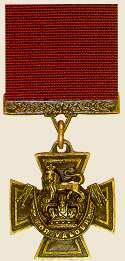
Of all the orders and decorations open to members of the Australian Defence Force, the Victoria Cross remains the most honoured, the most coveted. It marks its wearer as one possessing supreme courage, a disregard for danger and complete devotion to duty.
The Victoria Cross (VC) was instituted on 29 January 1856 and was made retrospective from 1 August 1854.
Prior to the Crimean War, there was no recognised gallantry medal, but the individual deeds in that war made the creation of such an award, available to officers and men alike, necessary.
The Victoria Cross, according to the Instituting Royal Warrant establishing rules and ordinances governing its bestowal, shall only be awarded for the most conspicuous bravery or some daring or pre-eminent act of valour or self-sacrifice or extreme devotion to duty in the presence of the enemy.
In the Commonwealth of Australia Gazette No. 525 Monday 4 February 1991, the Victoria Cross took its place as the highest Australian award in the Australian System of Honours and Awards. It may be awarded to members of the Defence Force or other persons determined by the Minister of State for Defence. Bars are awarded for further similar acts of bravery. The Victoria Cross may also be awarded posthumously and recipients are entitled to use the letters VC after their names.
The design remains identical in every way to the British award, a Maltese Cross in bronze adorned by a crown surmounted by a crowned lion, the emblem of the British royal family, in the centre, with a scroll bearing the inscription, ‘For Valour’. On the reverse is inscribed the date of the action. The name and regiment of the holder are inscribed on the back of the suspension bar. The ribbon is red for all Services, although until July 1918, the Royal Navy used the blue ribbon.

The medal ribbon group of Albert Jacka VC. The Victoria Cross ribbon is at the left from the viewer's perspective.
When worn, the VC takes precedence over all other awards, and is positioned to the far left of any medal group (as seen by the viewer - see image above).
The Cross has, from the first, been made by Messrs. Hancock, London jewellers and is hand fashioned. The metal used is taken from the guns captured from the Russians at Sebastopol during the Crimean War 1854-56.
The glorious fellowship of the Victoria Cross remains unique, it has no order nor chapel. The insignia is a small bronze cross costing a few dollars. It is confined to no caste, imposes no religious requirement nor colour bar. In the words of the Warrant ‘Neither rank nor long service, nor wounds, nor any other circumstance or condition whatsoever, save the merit of conspicuous bravery’ shall entitle a man to the award. The Cross has been granted to 13 persons of non-British origin, including three Danes, a German, a Swiss, a Belgian and one Ukrainian.
The first presentation of the new decoration was made by Queen Victoria in Hyde Park on 26 June 1857, when 62 sailors and soldiers received the award. The Prince Consort conceived the idea, but the Queen herself was personally responsible for much of the rest. She altered ‘For the Brave’ to ‘For Valour’ and ordered that the Cross should be awarded only ‘to those officers and men who have served us in the presence of the enemy.’
The first Australian to earn the Victoria Cross was Captain (later Sir Neville) Howse for rescuing a wounded man on 24 July 1900 while serving as an officer of the NSW Army Medical Corps during the South African War 1899-1902 (Boer War). As at March, 2002, the youngest Australian to be awarded the Victoria Cross was Private JWA Jackson VC, who was 18 years 9 months.
Prior to 1975, Australian service personnel were awarded gallantry, bravery and distinguished service awards under the Imperial system. Included in the new award system was the Victoria Cross for Australia (VC).
On 2 September 2008, TROOPER MARK GREGOR DONALDSON WAS AWARDED THE FIRST VICTORIA CROSS FOR AUSTRALIA for most conspicuous acts of gallantry in action in a circumstance of great peril in Afghanistan.
For more information about Trooper Donaldson go to
www.defence.gov.au/special_events/TPR_markDonaldson.htm
More information:
Lone Pine and The Nek (on this site). An account of a battle in which Australians were awarded seven Victoria Crosses.





